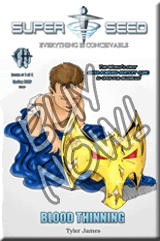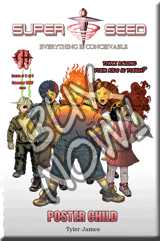
Where we've been... The Great Idea, Research is Key, The Killer Pitch, Characters That Make You Give A Damn, and Structurally Sound.
But today, oh today, is where we really have some fun with this writing thing. I hope the fire's in my eyes and my words are very clear, so let's...
VI. Beat It
The title of this series of articles is "My Writing Process" and in this one, I want to emphasize the MY. After all, there is more than one way to skin a cat (good God, who came up with that idiom? I mean, I'm a dog person, but still...) and certainly more than one way to build a story. But this process has been working for me, so that's why I'm sharing.
By this point in the process, I've already put in a lot of work, spending time doing idea development, research, character grids, and I have a general idea of what happens in the beginning, middle and the end of the story. Now it's time to stitch it together. It's time to plot the major beats of my story.
What do I mean by a beat? A beat is actually the smallest unit of a story. It's simply an action/reaction interaction of significance. Stories can have hundreds or thousands of beats. No, this article isn't about how to generate all of them. That comes in the writing. But what I find necessary to do prior to sitting down and writing is to figure out the major beats of my story. Once I've plotted the major beats, it becomes very easy to connect the dots and write that story. What follows are the major beats I focus on discovering prior to writing.
Opening Image: If you're writing for a visual medium like comics or film, it's important to make a good first impression. As such, I've been trying to pay attention to the opening image, and make it significant.

Here's a good example of a killer opening image. This silent splash page is how Frank Miller's award winning Sin City series kicked off. The story is about the death of a mysterious, beautiful girl named Goldie, and she's pictured here right off the bat. This image also establishes the noir feel of the comic.
Set-up: Figure out how to introduce most or all of the major players in your main storyline. It should be an interesting open, and one that reveals the character's status quo. In the set-up, you need to plant an idea of what is missing in the hero's life, what he wants and what she needs.

In my Sin City example, the set-up is that Marv, a hard-nosed brute, goes home with a beauty and doesn't question why she's interested in a loser like him.
Catalyst: This is the first major change in the status quo for your character. Stories usually start in balance, and the catalyst is that first moment that throws the story out of whack. This should happen early in your story, but generally, not before you've had a chance to briefly establish what life was like before this first turning point.

In Sin City, the catalyst is that Marv wakes up next to a dead Goldie. He knows he didn't kill her, and that's about all he knows.
Big Event: Hot on the heals of the catalyst, the big event is one that changes your main character's life in a major way. This big event is almost always a direct result of the catalyst, but raises the stakes, taking things to the next level.

Before Goldie's body is even cold, cops come for Marv, clueing him in to the fact that he's been set up. Marv fights with the cops and becomes a wanted man in Sin City. That's the big event.
B Storyline: Now, I'll admit, depending on the length and type of story, I don't always include B-storylines, probably to the detriment of my story-telling. However, it's a good idea to do so. In B storylines, you get the opportunity to introduce and develop new characters, and reveal more of the theme of the story. Pacing wise, B-storylines give your audience a break from the main storyline.
 Sin City doesn't have a big B-Storyline, but it does have one. After Marv's first run in with the cops, he goes to see his parole officer. Here a new character (one who will also show up later) is introduced, and we learn more about Marv (he's always in trouble and not taking his medication.)
Sin City doesn't have a big B-Storyline, but it does have one. After Marv's first run in with the cops, he goes to see his parole officer. Here a new character (one who will also show up later) is introduced, and we learn more about Marv (he's always in trouble and not taking his medication.)Fun and Games: This is where you deliver on the promise of your story. Again, envision the imaginary trailer for your story. What would it feature? Super hero's kicking ass? Slapstick comedy? Gruesome murders? This is the point in the story where you throw a lot of that stuff in.
 Marv wants answers and he doesn't care who he has to beat down to get them. For Marv, this truly is fun and games.
Marv wants answers and he doesn't care who he has to beat down to get them. For Marv, this truly is fun and games.Pinch: About half-way into the story, comes the pinch. This is another major turning point in the story. The pinch should be a twist, and often provides a point of no return for the character, where they become completely committed to their course of action, or their motivation is strengthened.
 In Sin City, the pinch is when Marv kills a priest in the confessional booth. (Yup, no turning back after that!) He's worked a trail of thugs back to a priest, and finds out the conspiracy is deeper than he could have ever imagined.
In Sin City, the pinch is when Marv kills a priest in the confessional booth. (Yup, no turning back after that!) He's worked a trail of thugs back to a priest, and finds out the conspiracy is deeper than he could have ever imagined.Crisis: Yet another turning point. Usually the low point in the script. The unthinkable happens, and all hope looks lost.
 In Sin City, this is when Marv realizes exactly what he's up against. He's found Goldie's killer and the little SOB kicked HIS ass. One of his only friends is killed. And the person behind it all is a one of the most powerful men in Sin City.
In Sin City, this is when Marv realizes exactly what he's up against. He's found Goldie's killer and the little SOB kicked HIS ass. One of his only friends is killed. And the person behind it all is a one of the most powerful men in Sin City.Showdown: Generally, the climax of the story...this is what you've been building toward. When your protagonist and antagonist square off, the stakes the highest they're ever going to be. Many times, the showdown also involves the merging of the A and B storylines.
 In Sin City, this is Marv's battle with Goldie's killer. It does not end well for the killer.
In Sin City, this is Marv's battle with Goldie's killer. It does not end well for the killer.Resolution: How does the thing end? Did the protagonist achieve his or her goals? How did he or she change or grow from the beginning? How are the loose ends tied up?
 The resolution in Sin City is that Marv tracks down Cardinal Rourke, the powerful man ultimately behind Goldie's death, and kills him, before being shot by cops, tried and condemned to death.
The resolution in Sin City is that Marv tracks down Cardinal Rourke, the powerful man ultimately behind Goldie's death, and kills him, before being shot by cops, tried and condemned to death.Final Image: Again, comics and film is a visual medium. When posible, leave the audience with a stirring image to replay in the brains. Bonus points for tying that final image to the opening image in some way.
 I'll let Sin City's final image speak for itself.
I'll let Sin City's final image speak for itself.Are there more beats? Of course. More major beats? Certainly. And certain genres have more specific beats not included above. For example, most romantic comedy feature "the cute meet." That's a major beat in that kind of story. But I've had a lot of success working with those major beats I just listed, and if the story calls for it, I can always add or subtract major beats in the plotting process.
To further illustrate, what follows are the major beats for CounterTERROR, my action/horror mash-up comic.
Opening Image: The National Counter-terrorism Center (NCTC.)

Set-Up: It's New Year's Eve and NCTC analysts have located a known terrorist in NYC and they've dispatched a team to bring him in. Meanwhile, FBI counter terrorism specialist Dorian McCullough, on mandatory medical leave, plans to enjoy the night with his fiance.
Catylst: The terrorist infects himself with a weaponized, flesh-eating virus.

Big Event: The SWAT team is also infected, and Dorian McCullough is dispatched to try to save Montoya, the one SWAT officer not infected.
B-Storyline: Dorian's fiance is pissed at him, and decides to take the subway to Times Square, unaware that another virus will be released there as well.
Fun and Games: Dorian and his partner race around the city trying to stop the spread of the virus.
Pinch: Dorian has to put down a former partner infected with the virus.
Crisis: Dorian's fiance is trapped in the subway with hundreds of the infective, and the virus is released in Time's Square.
Showdown: Dorian stops the spread of the virus with minimal casualties, but the main perpetrator gets away.
Resolution: Dorian gets to his fiance, and finds her alive.
Final Image: (Not gonna say. Still hope to tell this story someday, and it's got a shocker of an ending.)
So, that's my major beat sheet for CounterTERROR. Basically, these are waypoints that will keep me on track throughout my story. With these in place, it becomes a much easier exercise to connect the dots of my story. Hope this discussion helps, and as always, comments and feedback appreciated.
Next: VII. Memorable Scenes











No comments:
Post a Comment